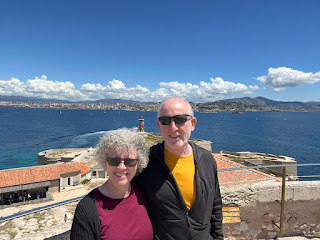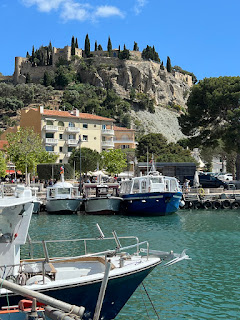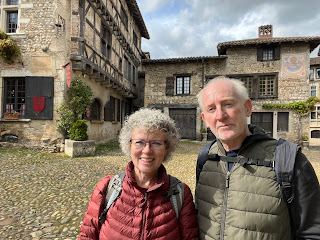 |
| Île d’If |
Our hopes of a relatively quick repair were dashed several times over as new problems were revealed, parts ordered and repairs awaited. We ended up extending our stay in the Golden Tulip hotel near the Marseille docks. From there we ventured farther afield and tried to relax into our new temporary local status.
Marseille is arguably Europe’s most ethnically diverse city and has as high a proportion of Muslims as anyplace in Western Europe. Getting from point A to point B often seems hectic and maybe even a bit dangerous since you’re never sure which, if any of the traffic laws will be obeyed. There are many streets completely taken over by graffiti. If you enjoy people-watching, this city is a smorgasbord. Wherever we travel we learn more about history but our inability to speak any other language fluently often reduces our interactions to the bare necessities. Sometimes we get lucky and someone shares more deeply or tries harder to communicate and it always leaves us with insights and a richer experience. Meeting people who’ve had to leave their countries of origin and start over in a strange land is both humbling and heart-rending. One of the hosts at our hotel was commiserating with our lengthy van repair and shared that he is a Syrian refugee who was hoping to get permission to travel outside the country after four months of waiting. He’s mastered French and English and probably other languages besides.
Île d’If
Just off the coast of Marseille are several islands accessible by ferry - we visited the storied Château d’If. Years ago there were efforts to use it for purposes of defense but it later became a notorious prison. It’s also a part of literary history as the prison featured in “The Count of Monte Cristo.”
We enjoyed roaming through the chateau, viewing the art installations, watching the fuzzy polka-dotted baby sea gulls and taking in the views of Marseille from the sea.
Aix-en-Provence
Based on the Fodors description, we expected a relaxed place with a focus on art and culture; beautiful leafy promenades; fountains; and high-end shopping and restaurants. The town looked as we expected but a huge Iron Man event monopolized the main street and charming side streets were bursting with throngs of tourists. We lunched in an Irish pub and found many, many others here.
According to Fodor’s the Caumont Centre d’Art is “housed in the glorious Hôtel de Caumont, one of the city’s most spectacular 18th century mansions . . .” It was very lovely and refined with a precious garden. It hosted an exhibition on Paul Bonnard which was excellent. They ran a film on “Cézanne in the Aix Region” which was the best we could hope for on the topic of Cézanne since his workshop and the house from which he often painted were both closed until 2025. We were able to glimpse the mountain he often painted on the bus ride back to Marseille.
Of course, we visited the Cathédral St-Sauveur but they were having a jam-packed Saturday service with positively ethereal singing so we didn’t see the main area, just the 5th century baptistery off to the side which was used for total-immersion baptisms.
Roaming the old town threading our way through the crush of tourists was exhausting so we eventually stopped for a cool drink at another Irish Pub (of course). We witnessed several batches of hen party goers and were even approached by one bride-to-be who asked if we were married. Our lack of nuptials deprived her and her friends of a scavenger hunt box check so they moved on quickly.
A woman in her late 60’s or early 70’s seated beside us struck up a conversation and we swapped life experiences through a combination of French, English, mime and google translate. She had been born in Madagascar and left as a young woman because “They didn’t need us” which we interpreted to mean there were no jobs. She conveyed that it had been very sad for her and she’d been torn away from her roots. She’d lived in many countries but since Madagascar had been a French colony, she now lived in Marseille and other members of her family now mostly lived in southern France as well.
Cassis
Alittle over an hour Southeast of Marseille by metro and bus, you can reach this adorable, relaxing port town. With the small sailboats in the harbor and the colorful houses, it reminded me of Cinque Terre, Italy.

Jardin Botanique de la Ville de Marseille in Parc Borély
We’ve noticed there are few green spaces in Marseille. Often trees have to make do with a square hole in the concrete frequented by dogs. So we began to crave some time in a park and garden. This was the most disappointing botanical garden we’ve ever visited. Much of it was closed off; greenhouses were empty; and there weren’t many interesting plants. On the plus side, there were birds.
“As you age, it’s ridiculous how fast bird-watching creeps up on you. You spend your whole life being 100% indifferent to birds, and then one day you’re like “damn is that a yellow-rumped warbler?” - iFunny
In the beginning of this trip I thought I’d dip my toe in. Now, with time on my hands, I took the eBird Introductory course and became convinced I could contribute to science. Now I’m roaming parks with my buddy Merlin telling me what’s singing. I wouldn’t say I’m hooked yet but it’s a possibility.
We got the word tonight that we that our campervan is fixed and we can pick it up tomorrow! Woo hoo!




























